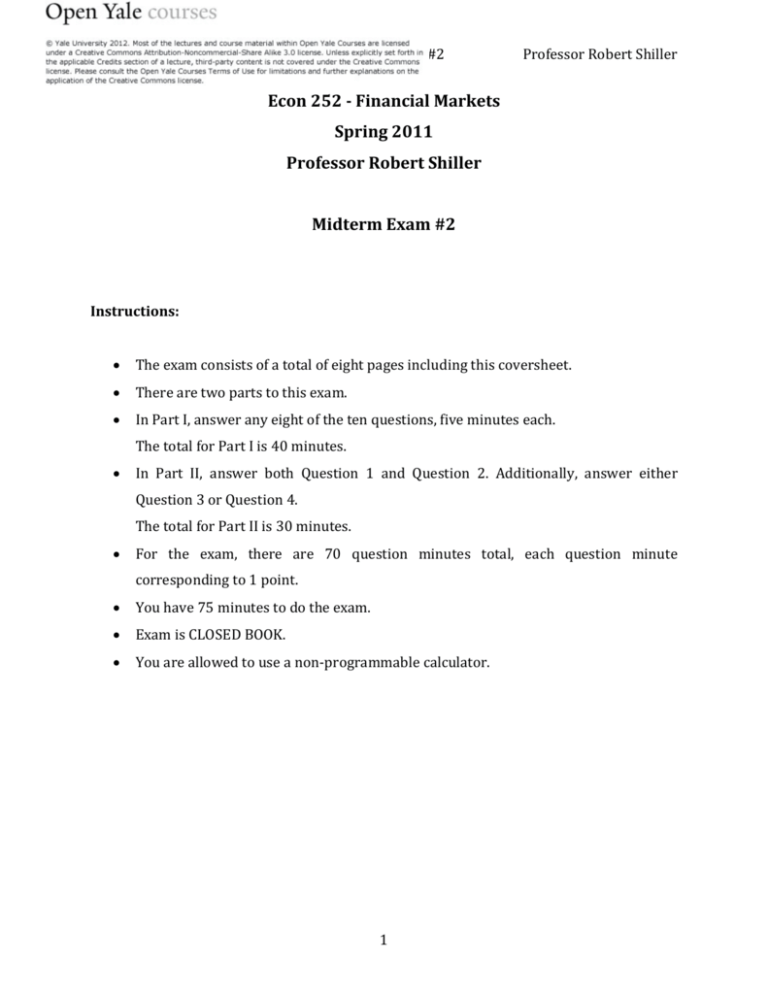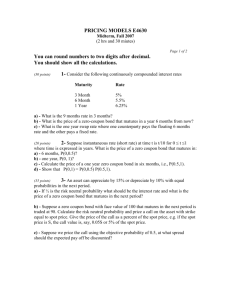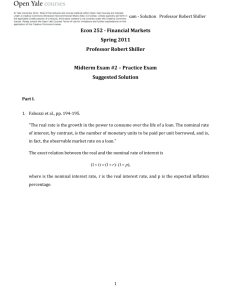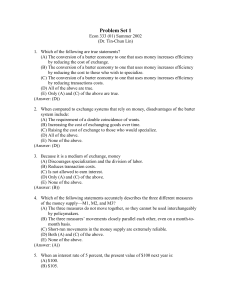Midterm Exam #2
advertisement

Econ 252 Spring 2011 Midterm Exam #2 Econ 252 - Financial Markets Professor Robert Shiller Spring 2011 Professor Robert Shiller Midterm Exam #2 Instructions: • • The exam consists of a total of eight pages including this coversheet. • There are two parts to this exam. • The total for Part I is 40 minutes. In Part I, answer any eight of the ten questions, five minutes each. In Part II, answer both Question 1 and Question 2. Additionally, answer either Question 3 or Question 4. • The total for Part II is 30 minutes. • corresponding to 1 point. • • For the exam, there are 70 question minutes total, each question minute You have 75 minutes to do the exam. Exam is CLOSED BOOK. You are allowed to use a non-programmable calculator. 1 Econ 252 Spring 2011 Part I. Midterm Exam #2 Professor Robert Shiller Answer eight of the ten questions (5 points each - 40 points total). 1. What is Fannie Mae, and what has happened to it recently? 2. How did mortgage finance change in the New Deal of the 1930s? 3. What is cognitive dissonance? Give an example of its relevance to finance. 4. Draw a diagram showing a Robinson Crusoe (one-person) economy where there is an exogenous production possibility frontier between consumption this year and consumption next year and, on the diagram, Crusoe’s indifference curves between consumption this year and consumption next year. How, then, is the (implicit) rate of interest determined? Illustrate the rate of interest on the diagram. Now, suppose a second person (named Friday) appears on the island, who faces the same production possibilities frontier. Friday is much more patient than Crusoe. Draw a second diagram illustrating trade between the two people, and illustrate how the interest rate is determined in the two-person economy. Does the interest rate rise or fall with the appearance of Friday? 5. How did Hank Greenberg say he built AIG into the biggest insurance company in the world? What did he say were his outstanding principles for success? PART I CONTINUES ON THE NEXT PAGE. 2 Econ 252 Spring 2011 Midterm Exam #2 CONTINUATION OF PART I. Professor Robert Shiller 6. What is TRACE? 7. What is a circuit breaker in finance? 8. What is the difference between microprudential and macroprudential regulation? 9. What is the principle behind “risk-weighted capital” as defined by the Basel Committee for banks? 10. What is a syndicated bank loan? 3 Econ 252 Spring 2011 Midterm Exam #2 Part II. Professor Robert Shiller Answer BOTH Question 1 AND Question 2. Additionally, answer EITHER Question 3 OR Question 4. (Questions 1 and 2: 10 points each - 20 points total, Questions 3 and 4: 10 points each – 10 points total). Question 1 (10 points) Suppose that you have a standard coupon bond with principal value $25,000 that matures in 2 years. The coupon rate is 3% and the coupon is paid semiannually with the first coupon payment occurring six months from now. (“Standard” refers to a non-callable bond contract.) (a) (3 points) If the price of the coupon bond is $24,290.36, is the yield approximately equal to 2%, 4%, or 4.5%? Either show at least one calculation or provide a detailed argument. (Hint: One of these three yield values is the correct answer.) For parts (b) and (c), the maturity of the above coupon bond will change. The coupon rate remains at 3%, and the coupon payment is still semiannually. (b) (2 points) If the coupon bond matures in 4 years and its price is $25,000, is the yield equal to 1.5%, 3%, or 5.25%? Either show at least one calculation or provide a detailed argument. (Hint: One of these three yield values is the correct answer.) QUESTION 1 CONTINUES ON THE NEXT PAGE. 4 Econ 252 Spring 2011 Midterm Exam #2 CONTINUATION OF QUESTION 1. Professor Robert Shiller (c) (3 points) If the coupon bond matures in 6 years and its price is $26,406.88, is the yield approximately equal to 2%, 3.25%, or 3.75%? Either show at least one calculation or provide a detailed argument. (Hint: One of these three yield values is the correct answer.) (d) (2 points) Using your answers for parts (a) through (c), sketch the yield curve of the coupon bond. What is the shape of the yield curve? 5 Econ 252 Spring 2011 Midterm Exam #2 Answer BOTH Question 1 AND Question 2. Professor Robert Shiller Question 2 (10 points) For this question, please use the 6-month convention for interest rates. Suppose that the annualized 18-month spot rate today is 2.5% and that the (annualized) forward rate today between 18 and 42 months equals 3.5%. (a) (3 points) Which spot rate (known today) can you compute from the information above? What is the annualized value of this spot rate? (b) (5 points) Assume that you will collect $a (a>0) 18 months from now and describe an investment strategy for this amount of money that allows you to replicate the forward rate today between 18 and 42 months. Importantly, you are only allowed to use the 18month spot rate and the spot rate computed in (a). When describing your investment strategy, carefully describe the steps that you take today and the consequences that these steps will have at any future moment in time. (Hint: In case that you are not able to compute the spot rate in part (a), you can describe the investment strategy by referring to the missing spot rate as z.) (c) (2 points) What is today’s expectation of the 24-month spot rate 18 months from now according to the Pure Expectations Theory? 6 Econ 252 Spring 2011 Midterm Exam #2 Answer EITHER Question 3 OR Question 4. Professor Robert Shiller Question 3 (10 points) Consider a borrower that is approved for a standard 15-year, fully amortizing mortgage with an original balance of $225,000 and a note rate of 8.4%. (“Standard” refers to a fixed-rate mortgage contract with level payments.) (a) (1 point) If the borrower purchases a house that is appraised for $350,000, what is the borrower’s LTV? (b) (7 points) Imposing the assumption that the borrower neither prepays nor defaults, write down part of the amortization schedule, limiting attention to months 121 and 122. Your amortization schedule should contain four columns: (1) Month, (2) Interest Payment, (3) Principal Repayment, (4) Remaining Mortgage Balance (in the beginning of the month). (c) (2 points) Maintaining the assumption that the borrower does not default, suppose that the borrower prepays $10,000 in month 122. Which quantity changes in the amortization schedule from part (b)? What is the remaining mortgage balance in the beginning of month 123 after the prepayment in month 122? 7 Econ 252 Spring 2011 Midterm Exam #2 Answer EITHER Question 3 OR Question 4. Professor Robert Shiller Question 4 (10 points) Consider a hypothetical pass-through security given a PSA assumption of 200 PSA. The underlying mortgages for this security are fixed-rate, level-payment 30-year mortgages and the pass-through rate is 5%. The WAM is 330 months and the WAC is 5.5%. Restrict attention to month 190 of this security. Suppose the outstanding balance in the beginning of month 190 is $180,000,000 and the mortgage payment is $1,500,000. Compute the following quantities: (a) (4 points) Net interest and scheduled principal for month 190. (b) (4 points) Prepayment for month 190. (c) (2 points) Outstanding balance in the beginning of month 191. 8







